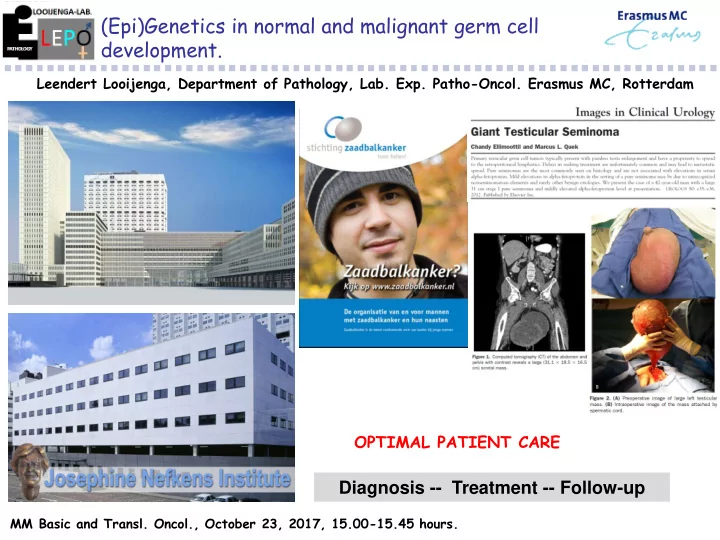

(Epi)Genetics in normal and malignant germ cell development. Leendert Looijenga, Department of Pathology, Lab. Exp. Patho-Oncol. Erasmus MC, Rotterdam OPTIMAL PATIENT CARE Diagnosis -- Treatment -- Follow-up MM Basic and Transl. Oncol., October 23, 2017, 15.00-15.45 hours.
Traditional classification(s) lack(s) biological basis. Extragonadal mainly type I & II Oosterhuis and Looijenga, Nat Rev Cancer 2005
Accepted WHO 2016 classification (testicular) II I III Spermatocytic seminoma
Human (sperm.) seminoma (tumor) [Type II-III] Morphology, epidemiology and behavior Stoop et al., Lab. Invest. 2001 mitosis/meiosis: XPA, SYCP1, SSX2-4 (Rajpert de Meyts et al., 2003: Chk2, p53, p16INK4d, MAGE-A4) Looijenga et al., Cancer Res 2006 aCGH (>#9) DMRT1 (Doublesex and MAB-3 related transcription factor) Sem./Dysgerm Sperm. Sem.
Additional markers Sperm. Seminoma (Tumor) Animal model DMRT1
Recent paper NGS (story closed?)
Focus Type II (TGCTs): Epidemiology. GENERAL POPULATION OBSERVATIONS Historical (main) risk factors: - Cryptorchidism - Sub/infertility - Familial predisposition TDS - Inguinal hernia - Birth weight - Hypospadias - DSD – (intersex) (THEORETICAL) ASSUMPTION: ALL (??????) Long term effect because of young patients & life expectancy: Infertility, Metabolic Syndrome, Vasc./Heart Damage, 2 nd Cancers
Precursor classification: acceptance WHO 2016. PRECURSOR TERMINOLOGY
Precursor classification: acceptance WHO 2016. PRECURSOR TERMINOLOGY
Overview pathology GCNIS related TGCT. COMMON PRECURSOR Blocked PGC/gonocyte PRE-INVASIVE: ( EMBRYONIC GERM CELL) Early gonadal development GCNIS (GB-DSD) seminoma embr. carc. 70% ~ 7 years INTRATUBULAR: INVASIVE: PLURIPOTENT (TOTI-/OMNI-) seminoma embr.carc. germ cells PURE or MIXED yolk sac tum. teratoma choriocarc.
Overview pathology & biomarkers (serum); selection. COMMON PRECURSOR OCT3/4 Blocked PGC/gonocyte PRE-INVASIVE: ( EMBRYONIC GERM CELL) Early gonadal development GCNIS (GB-DSD) seminoma embr. carc. OCT3/4 OCT3/4 70% ~ 7 years INTRATUBULAR: OCT3/4 OCT3/4 INVASIVE: PLURIPOTENT (TOTI-/OMNI-) seminoma embr.carc. germ cells Palumbo et al., 2001; Looijenga et al., 2003, De Jong et al., 2005, Cheng et al., AFP hCG 2006; De Jong and Looijenga, 2007, Van Casteren et al., 2008a,b, 2009, De Jong et al., 2008, Nonaka et al., 2009, Sonne et al, 2010, Gillis et al., 2011, Ushida et al., yolk sac tum. teratoma choriocarc. 2012, Eini et al., 2014, and many others.
Overview pathology & biomarkers (serum); selection. COMMON PRECURSOR OCT3/4 OCT3/4 SOX17 Blocked PGC/gonocyte PRE-INVASIVE: ( EMBRYONIC GERM CELL) Early gonadal development GCNIS (GB-DSD) seminoma embr. carc. OCT3/4 OCT3/4 OCT3/4 OCT3/4 70% SOX17 SOX2 ~ 7 years INTRATUBULAR: OCT3/4 OCT3/4 OCT3/4 OCT3/4 INVASIVE: SOX17 SOX2 PLURIPOTENT SOX17 (TOTI-/OMNI-) seminoma embr.carc. germ cells Palumbo et al., 2001; Looijenga et al., 2003, De Jong et al., 2005, Cheng et al., AFP SOX2 hCG 2006; De Jong and Looijenga, 2007, Van Casteren et al., 2008a,b, 2009, De Jong et al., 2008, Nonaka et al., 2009, Sonne et al, 2010, Gillis et al., 2011, Ushida et al., yolk sac tum. teratoma choriocarc. 2012, Eini et al., 2014, and many others.
SOX2 and 17 critical ES resp. PGC.
Biomarkers (WHO 2106) and dAP (PGC/ES). Similar (protein) patterns normal development & (T)GCTs (highly informative diagnostic markers)
DSD & (T)GCT precursors (relevance pathologists). DSD guideline 2017: LEPO = referral center (NL/B)
Possible overdiagnosis GCNIS (delayed maturation). OCT3/4 and SCF (KITLG): Distinction between delayed matured and (pre-)GCNIS -- versus ++ delayed maturation: (OCT3/4+/ KITLG-) Stoop et al., 2008 Sophia Children’s Hospital: Start 2002= 12/160 (7.5%) = 2 (17%) progressed; Update: ~200 orchidopexy biopsies (till end 2013, >250 to date); pre-GCNIS: 14 (7%); progression n=3 (21.4%; age after puberty), 1 bilateral in follow-up. Diagnosis based on (gonadal) tissue analysis; GWAS on TGCT cohorts Rapley et al., 2009; Kanetsky et al. 2009; Turnbull et al. 2010; Kratz et al., 2011; Ruark et al., 2013; Chung et al., 2013; ….. + KITLG [OR = 2.69 highest to date] + SPRY4 [inh. MAPK, downstream KITLG] + BAK1 [downstream KITLG] + DMRT1 [sex determination] + TERT, ATFIP [telomere maintenance] + UCK2, HPGDS, CENPE, CLPTM1L, MAD1L1, RFWD3, TEX14, PPM1E
TECAC + SNP update TGCT (germline variations).
SNP and DSD (Hum. Reprod.: 2017 in press).
Novel susceptibility variants (SNPs) (not GWAS)
From germline genetics to (T)GCT epigenetics.
DNA methylation-based TGCT insights. CNV (heterogeneity) Genomic imprinting Lineage similarities Pathway “activity”
Conclusions so far and expectations. Optimal ” pathological (WHO)/ clinical classification (also non-testicular) Identification of (general) risk population(s) ethnic origin (genetic basis) & clinical characteristics (TDS/DSD) (SNPs) Insight into pathogenesis (embryonic germ cell origin, including (epi)genetics) Identification (biology based) biomarkers (Tissue/Serum) OCT3-4/SOX2-17/(KITLG early age)/AFP/hCG (Tissue/Serum)/..... Risk stratification: * initial diagnosis * follow-up
TGCT versus ES/IPS cells – clinical relevance Potential of malignant behavior = (T)GCT??
Pre-clinical in vivo model = bridge disciplines (?) Daniela Salvatori, LUMC
mRNA profiling (cell lines vitro/vivo & TGCT)
miRNA profiling (cell lines vitro/vivo) down
miRNA profiling (cell lines vitro/vivo sera) EC TE (YST)
Overall conclusions and future perspectives Human germ cell tumors; a developmental disease. What we have: - “ Optimal ” pathological (WHO)/clinical classification (also non-testicular) - Identification of (general) risk population(s) ethnic origin (genetic basis) & clinical characteristics (TDS/DSD) (SNPs) - Insight into pathogenesis (embryonic germ cell origin) - Identification (biology based) biomarkers (Tissue/Serum) OCT3-4/SOX2-17/(KITLG early age)/AFP/hCG (Tissue/Serum)/..... What we will get: - Early stratification diagnosis (defined risk populations) - Understanding (genetic) heterogeneity (prim. tumor & metastases) - Informative molecular serum biomarkers (non-responders: relapse/resistance) - Putative target(s) treatment refractory disease
Human germ cell tumors; a developmental disease. (missing KW, KB JWO, HS YvB) LEPO Urologists and Pathologists, Patients Rev. Fund, ESMO, ESPE, Deutsche KrebsHilfe, EORTC, Dr. Mildred Scheel Foundation
Recommend
More recommend